Table of Contents
Introduction
According to Vegan Meat Statistics, Vegan meats crafted from ingredients like soy, peas, and wheat gluten are engineered to mimic the taste and texture of animal meats.
These alternatives are gaining popularity due to health benefits, such as being lower in saturated fats and cholesterol-free, and their reduced environmental impact, requiring fewer resources like water and land while also producing fewer greenhouse emissions.
With a variety of options available, including burgers, sausages, and nuggets, the market for vegan meat is expanding rapidly.
This growth is propelled by technological advances in food science, increasing consumer demand for sustainable and ethical food choices, and significant investment in the sector.
As a result, plant-based meats are now widely available in supermarkets, restaurants, and online platforms, appealing not only to vegetarians and vegans but also to a broader audience looking to reduce their meat consumption for health or environmental reasons.
Editor’s Choice
- The global vegan meat market revenue is expected to reach USD 19.1 billion by 2032.
- From 2018 to 2028, the average revenue per capita from meat substitutes has shown a consistent upward trend, starting from USD 0.64 in 2018 and anticipated to reach USD 2.09 by 2028.
- In the global landscape of meat substitutes market revenue, China leads with a significant USD 2,371 million.
- From 2018 to 2028, the price per unit of meat substitutes witnessed a consistent rise, starting from USD 0.64 in 2018 and projected to increase to USD 2.09 by 2028.
- A single cup of tempeh, recognized as a reliable source of nutrition, provides a substantial nutritional profile, containing 319 calories.
- In the realm of plant-based food and beverage choices, consumers prioritize health and wellness, with 57% citing both daily and long-term health promotion as extremely or very important factors.
- According to a recent report, 69% of consumers feel there is an insufficient variety of plant-based products or brands available, while 59% note a lack of different types of plant-based options, such as alternatives to chicken or seafood.
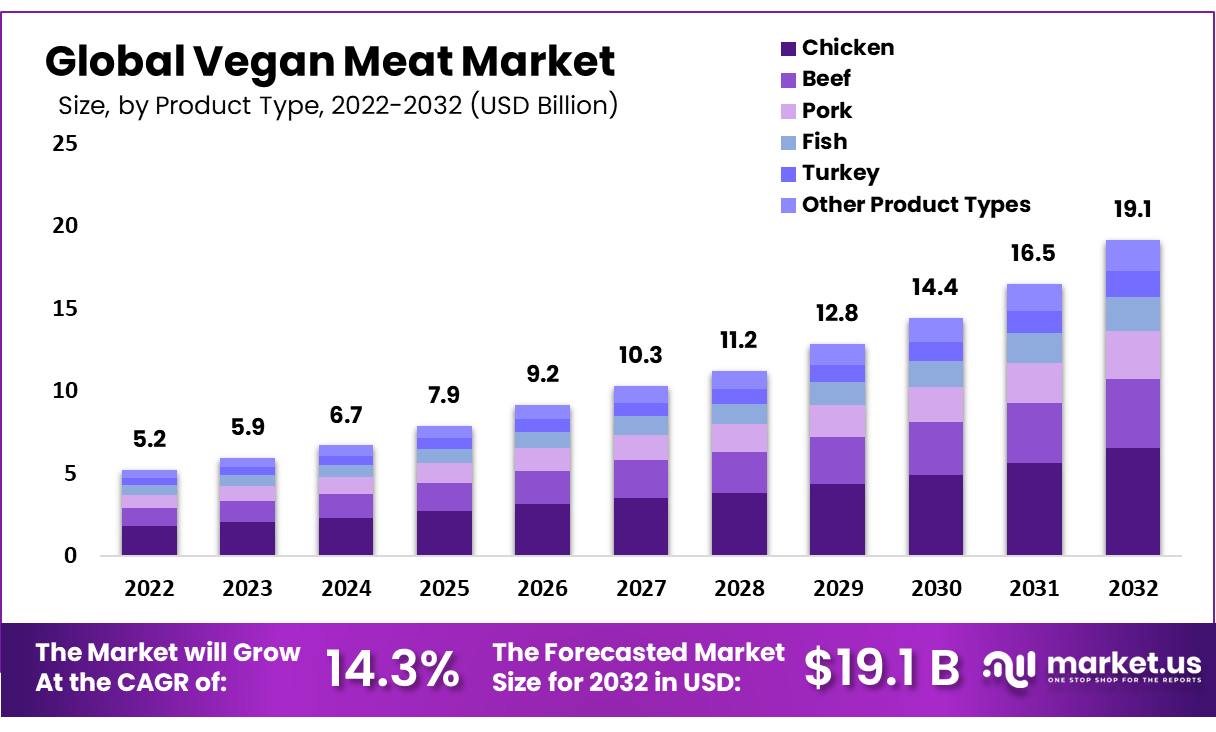
Vegan Meat Market Overview
Global Vegan Meat Market Size
- The global vegan meat market has experienced significant growth at a CAGR of 14.3%, with revenue increasing from USD 5.2 billion in 2022 to a projected USD 19.1 billion by 2032.
- This upward trajectory began with a revenue of USD 5.9 billion in 2023, followed by steady annual increases: USD 6.7 billion in 2024, USD 7.9 billion in 2025, and USD 9.2 billion in 2026.
- The growth persisted into the next decade, with revenues of USD 14.4 billion in 2030 and USD 16.5 billion in 2031, culminating in the forecasted USD 19.1 billion by 2032, reflecting the increasing consumer demand for plant-based meat alternatives and the sector’s dynamic innovation.
Meat Substitutes Market Overview
Global Meat Substitutes Market Size
- The global market for meat substitutes has shown a remarkable growth pattern at a CAGR of 10.20%, with revenues increasing from USD 4.66 billion in 2018 to an anticipated USD 16.78 billion by 2028.
- This progression saw a rise to USD 5.38 billion in 2019, followed by a significant jump to USD 6.63 billion in 2020, reflecting a growing consumer interest in alternative proteins.
- The market continued its upward trajectory, reaching USD 7.79 billion in 2021 and USD 8.96 billion in 2022.
- As consumer preferences for plant-based options strengthened, the market expanded to USD 13.99 billion in 2026, followed by USD 15.37 billion in 2027, and is projected to reach USD 16.78 billion by 2028, underlining the enduring appeal and growing acceptance of meat substitutes among global consumers.
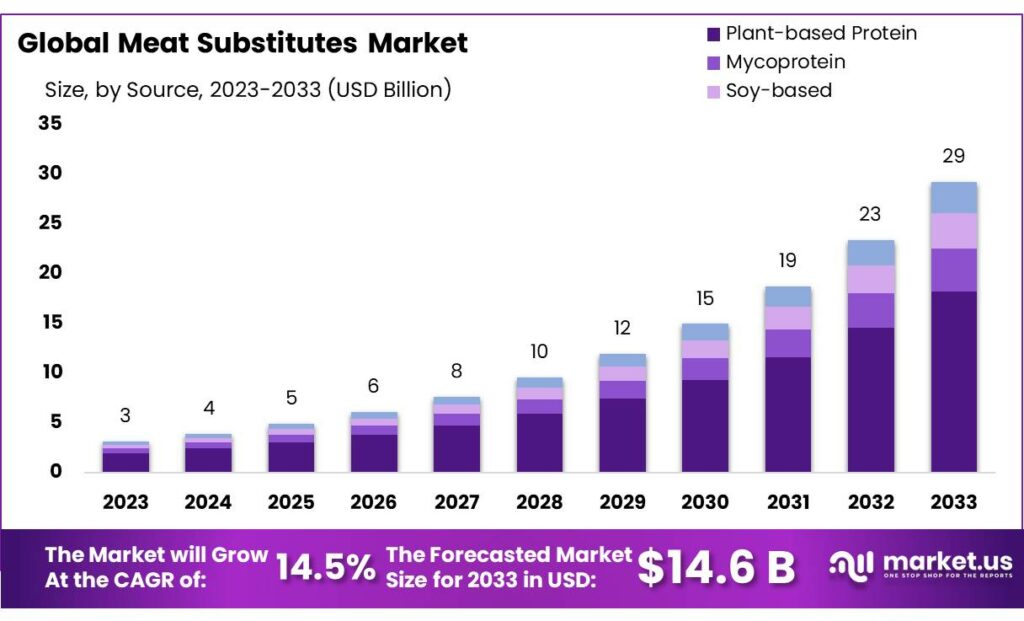
Average Revenue Per Capita of Meat Substitutes
- From 2018 to 2028, the average revenue per capita from meat substitutes has shown a consistent upward trend, starting from USD 0.64 in 2018 and anticipated to reach USD 2.09 by 2028.
- In 2019, the per capita revenue rose to USD 0.73, followed by a more substantial increase to USD 0.89 in 2020, indicating a heightened consumer interest.
- The upward trajectory continued, with the revenue per capita reaching USD 1.03 in 2021 and then USD 1.18 in 2022.
- This pattern persisted, with the revenue per capita advancing to USD 1.78 in 2026 and USD 1.93 in 2027, culminating in the projected USD 2.09 by 2028, showcasing the increasing value placed on meat substitutes by consumers globally.
Global Meat Substitutes Market Revenue – By Country
- In the global landscape of meat substitutes market revenue, China leads with a significant USD 2,371 million, followed closely by the United States at USD 2,060 million.
- The United Kingdom stands as the third largest market, generating USD 1,106 million.
- Russia and Germany show comparable market sizes, with revenues of USD 776 million and USD 774 million, respectively.
- The Netherlands also presents a noteworthy market at USD 358 million, with Japan slightly behind at USD 323 million.
- Indonesia and Canada contribute to the market with revenues of USD 298 million and USD 289 million, respectively, while Mexico rounds out this list with a market revenue of USD 254 million.
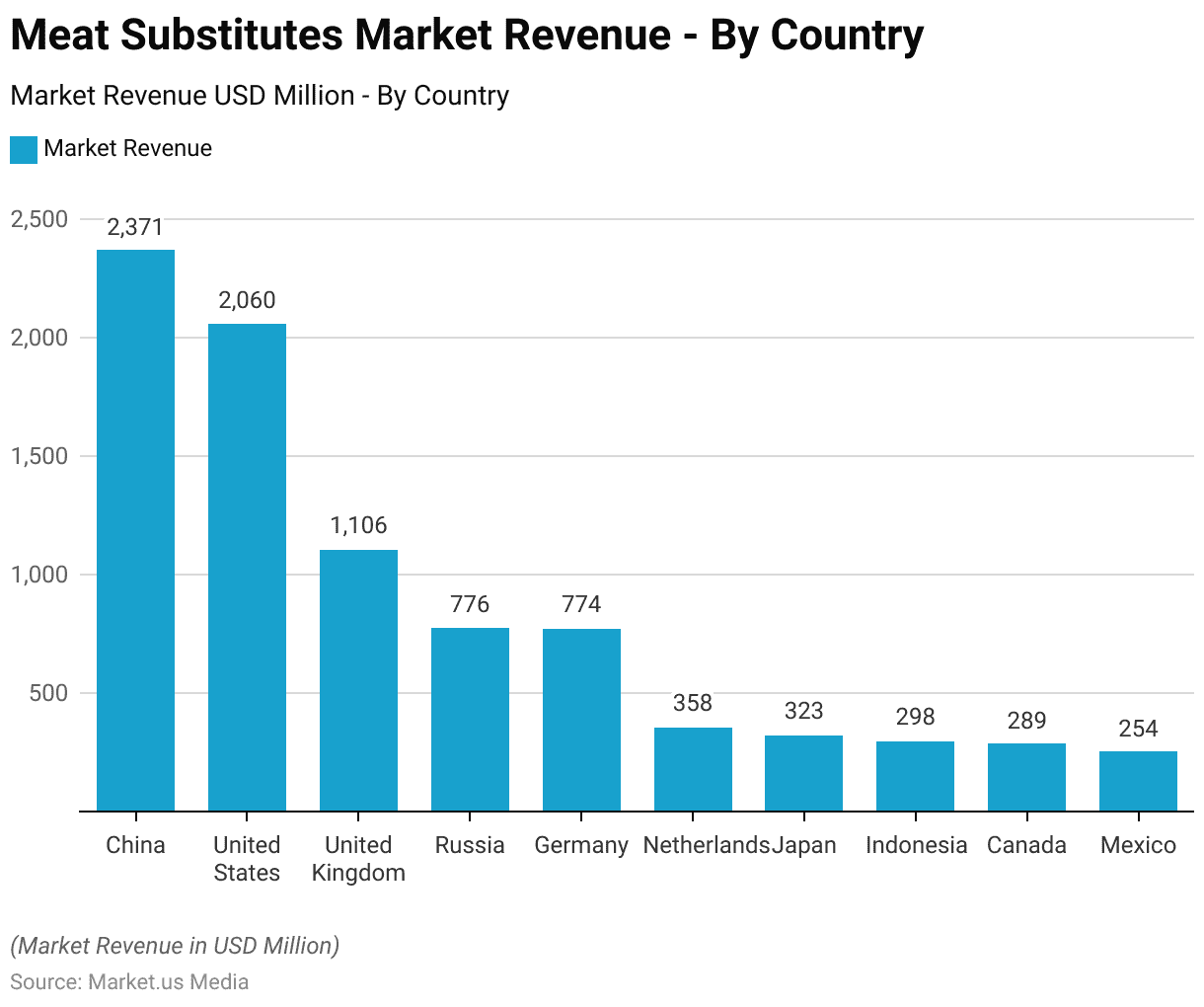
Price of Meat Substitutes
- From 2018 to 2028, the price per unit of meat substitutes witnessed a consistent rise, starting from USD 0.64 in 2018 and projected to increase to USD 2.09 by 2028.
- The year 2019 saw the price per unit climb to USD 0.73, and this upward movement continued with a jump to USD 0.89 in 2020, reflecting an escalating consumer interest in such products.
- The trajectory of growth persisted, with the price per unit reaching USD 1.03 in 2021, USD 1.18 in 2022, and further to USD 1.32 in 2023.
- The following years witnessed consistent increases: USD 1.47 in 2024, USD 1.63 in 2025, advancing to USD 1.78 in 2026, and USD 1.93 in 2027, before reaching the forecasted USD 2.09 by 2028.
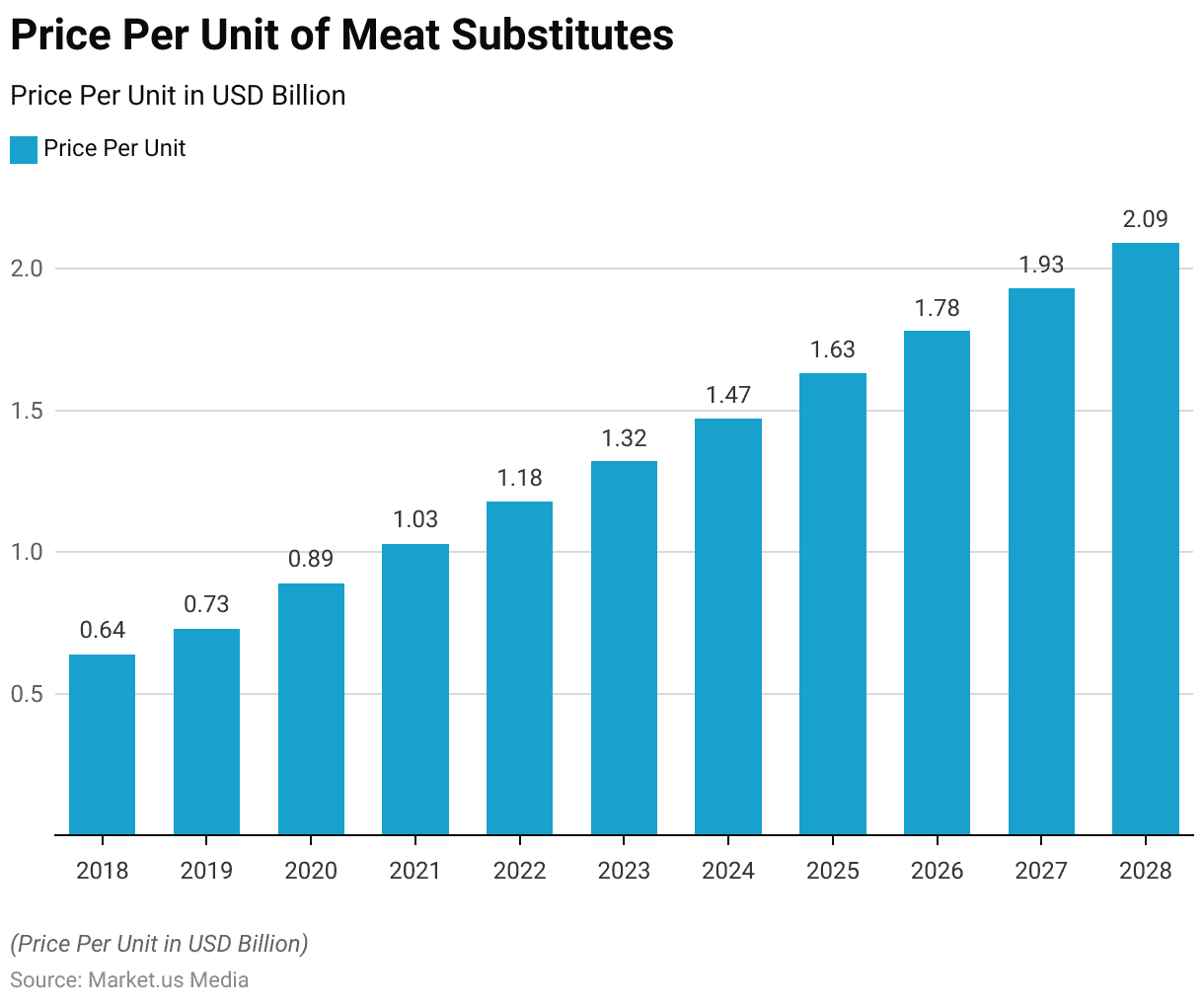
Nutritional Value of Different Vegan Meat Products
Tempeh
- A single cup of tempeh, recognized as a reliable source of nutrition, provides a substantial nutritional profile, containing 319 calories.
- It is particularly rich in protein, offering 33.7 grams, alongside 17.9 grams of fat. In terms of minerals, this portion delivers 184 milligrams of calcium and 4.48 milligrams of iron, contributing significantly to the daily nutritional requirements.
- Additionally, tempeh is lauded for being a good source of magnesium and vitamin B-6, further enhancing its value as a nutritious component of a balanced diet.
Seitan
- A 4-ounce serving of seitan, acknowledged by trusted sources for its nutritional content, offers 140 calories, making it a low-calorie option for many diets.
- It is exceptionally high in protein, providing 28 grams while containing a minimal 2 grams of fat, positioning it as a lean protein source.
- Notably, seitan is enriched with several vitamins, being high in riboflavin, niacin, and vitamin B-6, which play crucial roles in energy metabolism and overall health.
- However, it is important to note that seitan does not contain calcium or iron, two nutrients essential for bone health and oxygen transport in the body, respectively.
Textured Vegetable Protein (TVP)
- A 1-cup (dry) serving of Textured Vegetable Protein (TVP) derived from soy presents a nutritionally dense profile with 222 calories.
- It stands out for its high protein content, offering an impressive 35 grams, alongside a very low-fat content of just 0.83 grams, making it an ideal choice for those seeking lean protein sources.
- This serving also provides 164 milligrams of calcium and 6.28 milligrams of iron, essential minerals for maintaining strong bones and healthy blood.
- Additionally, it contains 11.9 grams of fiber, contributing significantly to daily dietary fiber requirements and promoting digestive health.
Consumer Preferences for Plant-Based Meat
Consumer Preferences: Traditional Hamburger vs. Plant-based Meat Alternatives
- The comparison between consumer preferences for traditional hamburgers and plant-based meat alternatives reveals significant trends.
- While taste, price, and familiar ingredients lead 68%, 65%, and 59% of consumers to favor hamburgers, respectively, ethical and environmental considerations begin to bridge the gap for plant-based meats.
- Although only 12% prefer the taste of plant-based options, and their price and ingredient list are less favored (13% and 22%), these alternatives gain ground in areas like animal welfare (40% vs. 44% for hamburgers), health (35%), and environmental impact (37%).
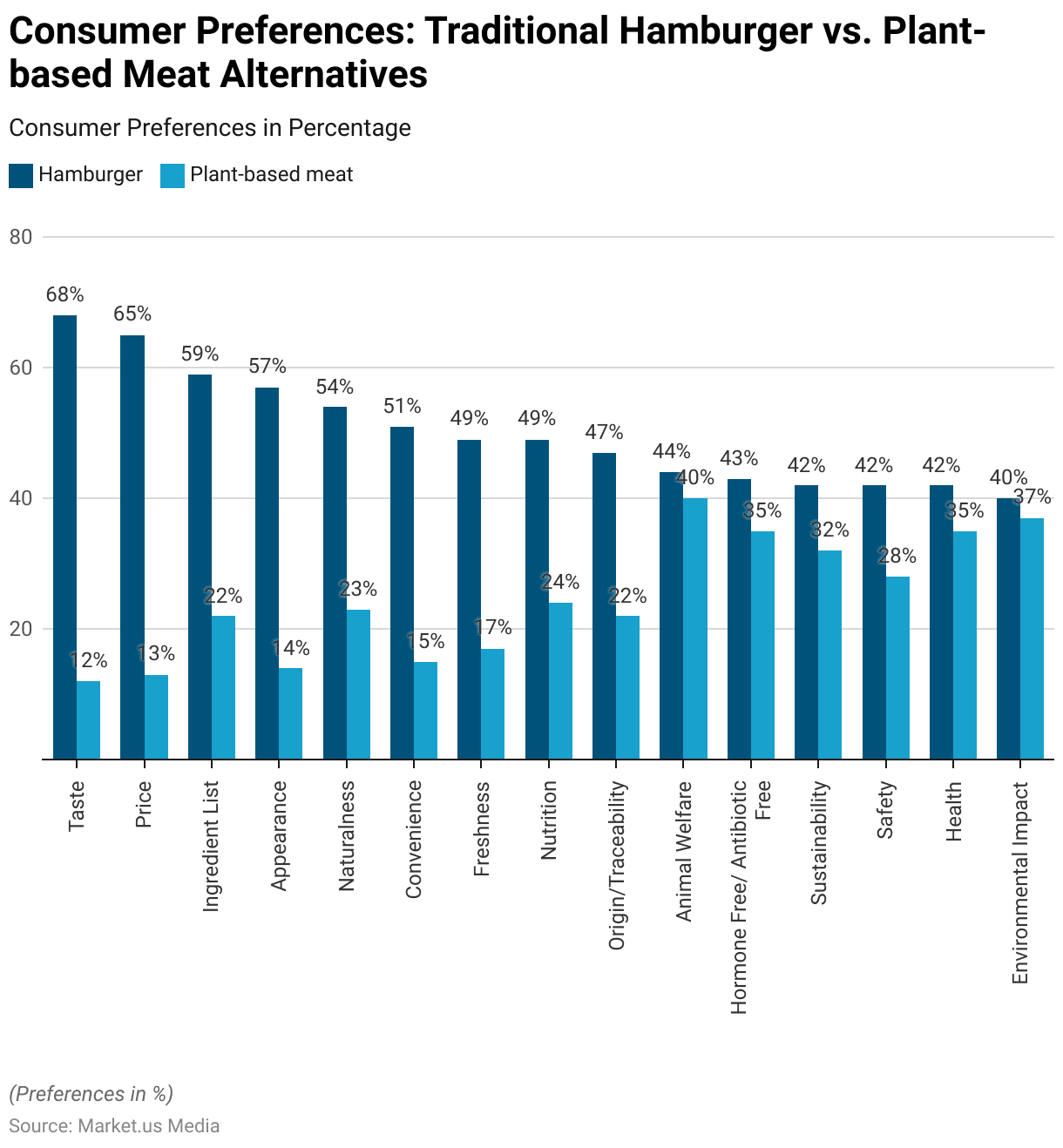
Important Factors Driving Plant-based Food/Beverage Choices
- In the realm of plant-based food and beverage choices, consumers prioritize health and wellness, with 57% citing both daily and long-term health promotion as extremely or very important factors.
- Disease prevention is also a significant driver, valued by 53% of consumers, while 52% seek the energy benefits associated with plant-based diets.
- Taste preference is a key factor for 49% of consumers, highlighting the importance of flavor in the adoption of plant-based options.
- Eating clean and providing better treatment of animals are closely aligned in importance, at 48% and 47%, respectively, suggesting that ethical considerations are also pivotal.
- Lifestyle preferences and environmental or sustainability reasons each hold a 44% importance rating, indicating that for a substantial portion of consumers, plant-based choices are part of broader personal and ecological values, underscoring the multifaceted motivations behind the shift towards plant-based eating.
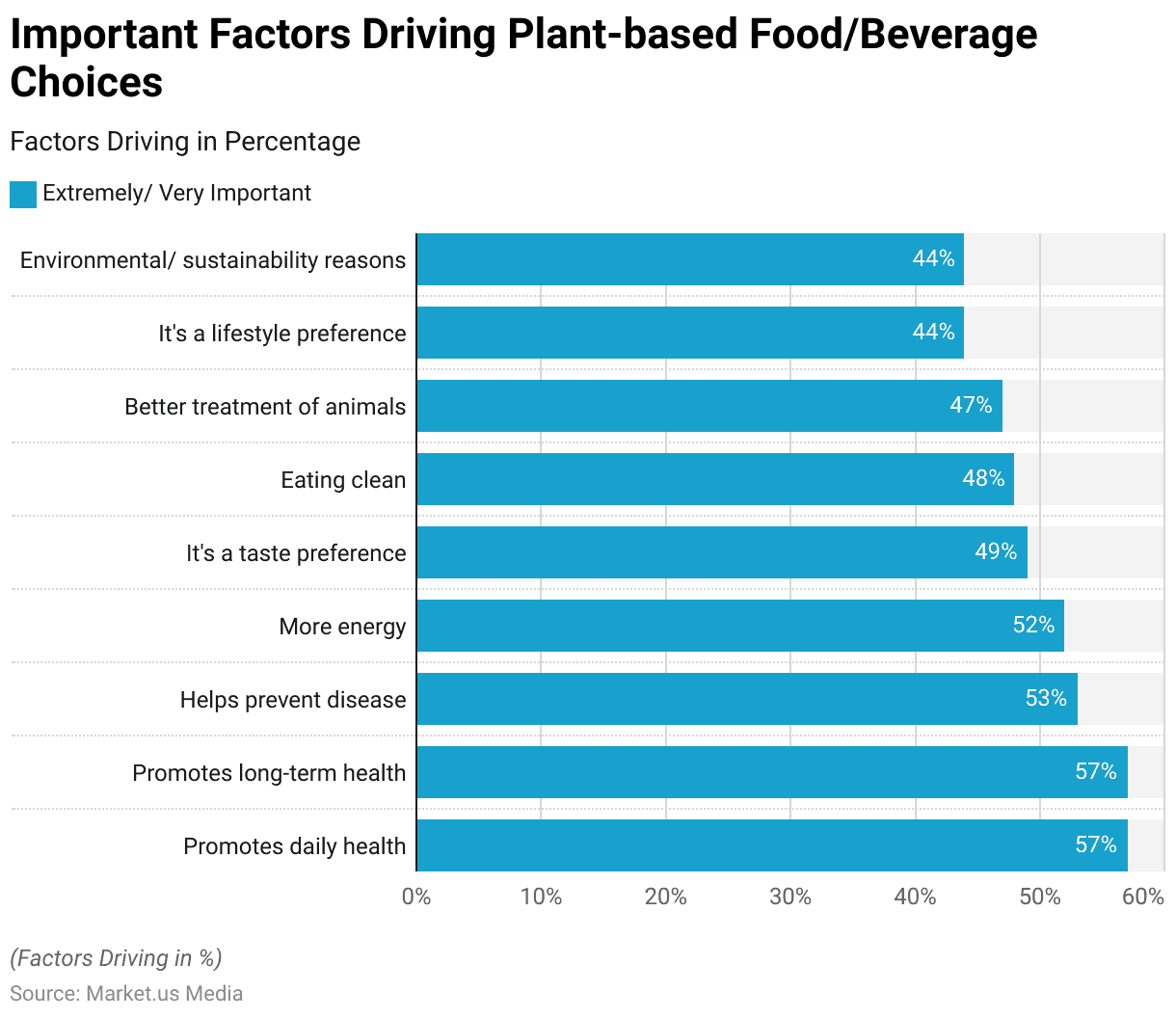
Challenges and Future Perspective
- According to a recent report, 69% of consumers feel there is an insufficient variety of plant-based products or brands available, while 59% note a lack of different types of plant-based options, such as alternatives to chicken or seafood.
- Given the high priority consumers place on natural products, it’s not surprising that there’s some hesitation toward lab-grown, cultured products despite their potential benefits.
- Currently, no more than 20% of consumers are open to trying such meat alternatives. Still, there’s an expectation that acceptance may grow as these products become more familiar and understood by the broader public.
Discuss your needs with our analyst
Please share your requirements with more details so our analyst can check if they can solve your problem(s)



